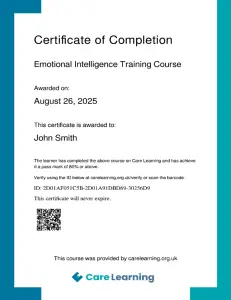Safer recruitment is essential in health and social care to protect vulnerable children and adults from harm. Every stage of the recruitment process — from job adverts to induction — must place safeguarding at the centre to ensure only suitable and trustworthy individuals are employed.
This free safer recruitment online course provides a comprehensive introduction to safer recruitment, covering the principles, legal requirements, and practical steps needed to implement a robust and safeguarding-focused recruitment process.
Why Take This eLearning Course?
Recruiting safely is not just good practice — it’s a legal and ethical responsibility. By completing this course, you’ll gain the confidence to design and carry out recruitment processes that prioritise safeguarding and comply with UK legislation.
Here’s why this course is for you:
- Understand safer recruitment principles: Learn why safeguarding must be embedded into every recruitment stage.
- Plan effectively: Prepare recruitment campaigns that highlight your organisation’s safeguarding commitment.
- Apply best practices in selection and interviews: Use structured processes to ensure fairness and safety.
- Carry out vetting and pre-employment checks: Understand how to use DBS checks, references, and identity verification correctly.
- Manage post-recruitment responsibilities: Explore induction, training, supervision, and probationary periods.
- Stay compliant with the law: Learn about the Care Act 2014, the Safeguarding Vulnerable Groups Act 2006, and other key regulations.
Module 1: Safer Recruitment Principles
Learners will explore the role of safer recruitment in safeguarding vulnerable individuals. They will review the legal and ethical obligations that underpin recruitment in health and social care settings and understand why safer recruitment is a cornerstone of safeguarding practice.
Module 2: Pre-Recruitment Planning
This module covers the essential steps in preparing for recruitment, including drafting and advertising posts. Learners will also examine how organisations demonstrate their commitment to safeguarding throughout the recruitment planning process.
Module 3: Recruitment Process
Learners will review the four key stages of recruitment—planning, selection, interviews, and post-recruitment. The module highlights how safeguarding principles must be embedded throughout the process and shares best practices for candidate selection. Learners will also watch a video explaining the DBS check process, followed by a knowledge check.
Module 4: Vetting and Pre-Employment Checks
This module introduces the range of vetting and pre-employment checks required for safe recruitment. Learners will explore DBS checks, identity verification, and reference checks, and consider how to manage anomalies, criminal records, or gaps in employment history.
Module 5: Post-Recruitment Activities
Learners will understand the importance of induction, training, and supervision in maintaining safe practice. The module also explores the role of probationary periods, ongoing monitoring, and the steps organisations must take if safeguarding concerns arise after recruitment.
Module 6: Relevant Legislation, Policies and Leavers
This final module reviews the key legislation governing safer recruitment, including the Safeguarding Vulnerable Groups Act 2006 and the Care Act 2014. Learners will examine employer responsibilities under safeguarding law, the need for compliance with current regulations, and the steps required when managing leavers and referrals. A knowledge check consolidates learning.
Learning Outcomes
By the end of this course, learners will be able to:
- Explain the role of safer recruitment in safeguarding vulnerable individuals.
- Identify legal and ethical obligations for recruitment in health and social care.
- Plan effective recruitment campaigns that prioritise safeguarding.
- Apply best practice throughout the recruitment process, including shortlisting and interviews.
- Conduct appropriate vetting and pre-employment checks, including DBS, references, and identity verification.
- Recognise how to manage anomalies such as criminal records or employment gaps.
- Outline the role of induction, training, and supervision in safer recruitment.
- Understand employer responsibilities under current safeguarding legislation.
- Describe procedures for managing leavers and making referrals when necessary.
Target Audience
This course is suitable for:
- Managers and team leaders involved in recruitment.
- HR professionals in health and social care organisations.
- Designated safeguarding leads.
- Anyone responsible for hiring or overseeing staff who work with vulnerable people.
No prior recruitment training is required — the course introduces all the core principles and practical steps clearly and accessibly.
FAQ
What does the course cover?
It covers every stage of safer recruitment, from advertising posts and conducting interviews to pre-employment checks, induction, and compliance with safeguarding laws.
Can I apply what I learn immediately?
Yes. The course provides practical tools and frameworks that can be integrated straight into recruitment processes.
How long will it take?
Most learners complete the course in 1 hour, but it is self-paced so you can study at your convenience.
Will I receive a certificate?
Yes. A certificate will be issued upon successful completion.
Is this course relevant to UK health and social care?
Yes. It is fully aligned with UK safeguarding legislation and CQC expectations.
Is it CPD accredited?
Accreditation is in progress, and certificates will be updated once CPD approval is confirmed.
Safer recruitment is vital to maintaining safe, effective, and trusted services. By completing this course, you’ll gain the knowledge and tools to strengthen safeguarding within your organisation and ensure compliance with UK regulations.
👉 Enrol today and take the first step towards safer recruitment practices in health and social care.
You must log in and have started this course to submit a review.






